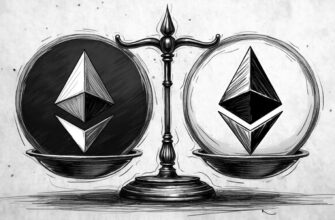- The Dawn of a New Staking Model
- A Non-Inflationary Breakthrough
- Fixed Supply and Diverse Reward Sources
- Rewards in Real-Time, No Lock-In Required
- Security and Participation Without Cost
- Cutting-Edge Cryptographic Solutions
- No Slashing Penalties
- Global Ramifications and Blockchain Growth
- Boosting Blockchain in Nigeria
- Navigating Potential Regulatory Challenges
- Future Prospects for Decentralized Platforms
- Possible Influence on Other Blockchain Networks
- Extending Beyond Finance
- Recap: Algorand’s Role in Blockchain Evolution
The Dawn of a New Staking Model
Algorand has just rolled out a new staking rewards program that is shaking things up in the blockchain world. This isn’t just any program; it’s designed to offer real-time rewards without the pesky inflation that often plagues such systems. With a focus on security and inclusivity, Algorand is making waves. Unlike the traditional staking setups that come with slashing penalties and long token lockup periods, this model is all about being user-friendly and secure for validators. Let’s take a closer look at what makes Algorand’s staking program stand out and what it might mean for the larger crypto market and different sectors.
A Non-Inflationary Breakthrough
Fixed Supply and Diverse Reward Sources
What truly sets Algorand’s staking model apart is its non-inflationary nature. Unlike the typical inflation-based models that churn out new tokens as a way to incentivize staking, Algorand is tapping into transaction fees and a pre-funded treasury to dish out rewards. This means that the supply of ALGO tokens remains fixed, thereby preventing dilution over time. By having a stable token supply, Algorand manages to keep the economic value and scarcity of its tokens intact, which is a major departure from a lot of other proof-of-stake networks.
Rewards in Real-Time, No Lock-In Required
In this staking setup, validators are being rewarded in real-time with an initial 10 ALGO per block and a gradual decline of 1% per millionth block. Plus, they pocket 50% of transaction fees from the blocks they propose. This model shuns lockup periods, allowing users to have control over their assets whenever they please. This flexibility and ease of use could boost participation and is a significant move towards inclusivity.
Security and Participation Without Cost
Cutting-Edge Cryptographic Solutions
Algorand has employed a Pure Proof-of-Stake (PPoS) consensus mechanism, utilizing top-tier cryptographic techniques like Verifiable Random Functions (VRF) and cryptographic sortition. This ensures the network’s security through the random selection of block proposers and validators based on their stake. Unlike other models that rely on slashing penalties to enforce security, Algorand has found a way to sidestep these hazards, making it a more secure and appealing option for participants.
No Slashing Penalties
The usual staking models come with slashing penalties to maintain security, a risk that validators often face. However, Algorand’s model ditches this idea, as it doesn’t impose penalties for technical failures or downtime. Poorly performing nodes are simply removed from the consensus circle without punishment. This approach not only encourages more participation but also maintains security through economic incentives and a decentralized control structure.
Global Ramifications and Blockchain Growth
Boosting Blockchain in Nigeria
Algorand has taken a major role in promoting blockchain development in Nigeria, which saw its National Blockchain Policy enacted in 2023. The Algorand Foundation trained over 500 software developers and held workshops in Plateau State for 50 additional individuals. Nigerian teams also shone at Algorand’s Global Hackathon, clinching top spots in Consumer, Impact, and DeFi categories. Moreover, a policy dinner in December 2023 opened the doors for discussions with government leaders to explore integrating blockchain into public services, thus pushing the digital transformation of the nation.
Navigating Potential Regulatory Challenges
With crypto staking entering more mainstream territory, it’s likely that regulatory scrutiny will ramp up. Recent developments in the UK, such as the HM Treasury’s “Staking Order”, offer a glimpse into how staking programs might be treated. This order clarifies that certain crypto-asset staking arrangements do not fall under a Collective Investment Scheme (CIS), exempting eligible staking from intricate regulatory frameworks. Clear regulatory guidelines will be crucial for investor protection, compliance promotion, and transparency enhancement, ultimately building confidence in the durability of crypto staking.
Future Prospects for Decentralized Platforms
Possible Influence on Other Blockchain Networks
Algorand’s revolutionary approach to staking rewards could set a precedent for other decentralized platforms. With its non-inflationary framework, immediate payouts, and absence of lockup periods or slashing penalties, we might see other blockchain networks considering similar models. This could lead to improved network security, decentralization, and user accessibility across the blockchain space.
Extending Beyond Finance
Algorand’s staking rewards program might pave the way for blockchain technology’s adoption beyond just financial realms. This added layer of security and decentralization could enhance the blockchain’s reliability for diverse sectors like healthcare, supply chain management, and electoral systems. Algorand’s emphasis on interoperability and scalability tackles the fundamental issues that have hindered broader blockchain adoption in other industries.
Recap: Algorand’s Role in Blockchain Evolution
Algorand’s staking rewards program brings multiple advantages over traditional inflationary models, including a fixed token supply, real-time rewards without lockup periods, and security mechanisms that don’t hinge on slashing penalties. These elements make Algorand’s model more secure, easier to use, and more conducive to widespread network participation. As Algorand continues to innovate, its staking approach could very well set the benchmark for decentralized platforms and fuel the integration of blockchain technology across various industries.








